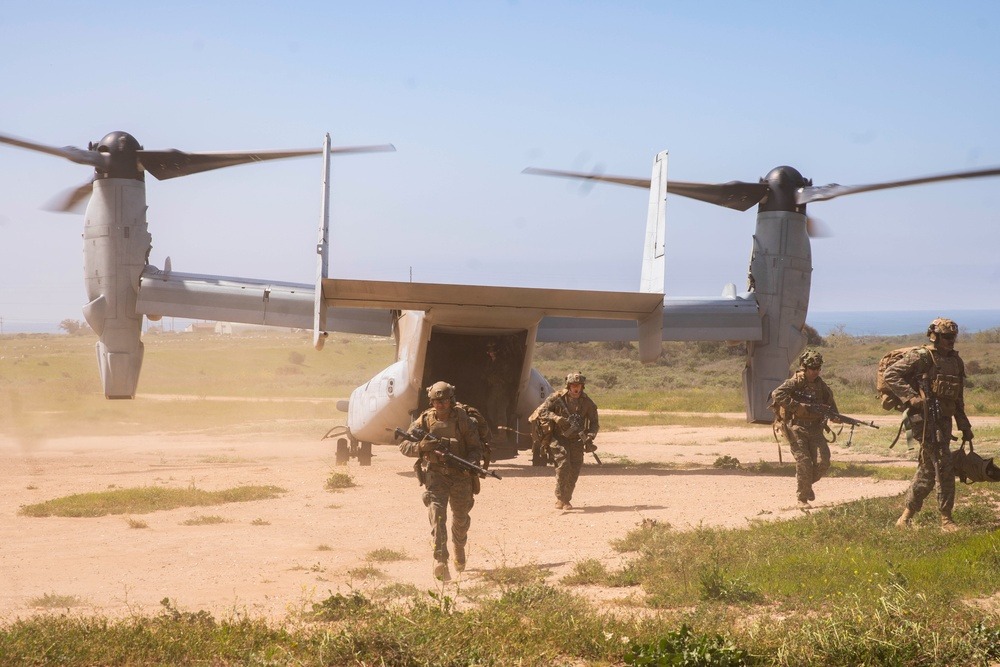
Story by Capt. Brian Tuthill, 15th Marine Expeditionary Unit
MARINE CORPS BASE CAMP PENDLETON, Calif. – The 15th Marine Expeditionary Unit began MV-22B Osprey reintegration training March 21, transporting a platoon of Marines across Camp Pendleton to regain proficiencies in foundational skills for pilots and infantry Marines.
The training was conducted at two sites and involved a section of MV-22B Ospreys from Marine Medium Tiltrotor Squadron 165 (Reinforced), part of the aviation combat element of the 15th MEU, and Marines with Bravo Company, Battalion Landing Team 1/5, the 15th MEU’s ground combat element.
Bravo Company is BLT 1/5’s airborne assault company for the 15th MEU.
“This type of reintegration training is an important step in returning our pilots and enlisted aircrew to full proficiency and readiness to support the 15th MEU,” said Lt. Col. Drew Bossart, the commanding officer of VMM-165 (Rein.). “We continue to follow the Marine Corps’ deliberate, three-phased approach as our pilots regain basic flight currency, rebuild our instructor cadre, and achieve proficiencies. I am fully confident in our aircraft and that our pilots and aircrews will soon achieve a high state of operational readiness.”
Pilots first landed Ospreys at Camp Pendleton’s helicopter outlying landing field, or HOLF, in the San Mateo area. The HOLF has a section that matches the flight deck dimensions of a U.S. Navy amphibious assault ship, which allows pilots to simulate landing on a ship. The pilots exited their aircraft to meet with leaders from Bravo Company on the ground and provided instructions to the Marines waiting to board the aircraft. Bravo Company Marines then conducted multiple boarding and disembarking drills at the HOLF in the same manner they did previously during at-sea training aboard USS Boxer (LHD 4).
Following the landing zone drills in San Mateo, VMM-165 (Rein.) pilots transported Bravo Company Marines to a confined area landing site in the Las Flores area. The CAL site is a landing zone that that requires pilots to maneuver around obstacles such as trees, powerlines, or buildings to land. These types of landings prepare pilots and crew chiefs for unpredictable terrain and situations they may encounter in an expeditionary environment. Bravo Company Marines exited the aircraft and established security to simulate how they would insert and extract at a landing zone during a mission before reembarking the aircraft.
Following the training at the CAL site, Bravo Company’s Marines were flown back to San Mateo for their final landing and the Ospreys returned to their squadron headquarters at Marine Corps Air Station Miramar.
“MV-22s are the cornerstone of the 15th MEU’s Marine Air-Ground Task Force, providing us unrivaled flexibility for expeditionary operations across the spectrum of military operations and movement from ship to shore,” said Col. Sean Dynan, the commanding officer of the 15th MEU. “VMM-165’s pilots and aircrews have the full support of the 15th MEU as they take a measured approach to progress through all requirements carefully and deliberately.”
VMM-165 (Rein.) and the 15th MEU will continue to conduct progressive training events over the coming weeks, both ashore and at sea.
MV-22B Ospreys are multi-engine, dual-piloted, self-deployable, medium lift, vertical takeoff and landing (VTOL) tiltrotor aircraft designed for combat assault support, combat service support, and special operations missions worldwide. Ospreys have the ability to carry 24 Marines and Sailors twice as fast and five times farther than previous helicopters, flying at 240 knots and up to 200 nautical miles.
- Red Sea Update - April 26, 2024
- U.S. Begins Construction on Temporary Pier to Deliver Humanitarian Aid to Gaza - April 26, 2024
- IKE Carrier Strike Group Arrives in the Eastern Mediterranean - April 26, 2024






